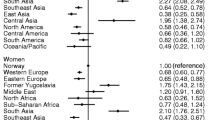Abstract
Purpose
We undertook a study investigating whether immigrants from Turkey, Pakistan and Yugoslavia received adequate medical treatment with beta-blockers and statins after acute myocardial infarction (AMI) when compared with Danish-born residents and explored whether associations between patient origin and medical treatment were mediated by socioeconomic status (SES).
Methods
This register-based follow-up study consisted of individuals >17 years of age, admitted to hospital with AMI between 2001 and 2005 (n = 25 443). Danish-born residents were compared with immigrants from Turkey, Pakistan and Yugoslavia. Individuals were identified by civil registration number, and data were obtained through linkage to the national registers of hospitalisations and drug prescriptions. Odds of initiating treatment and hazard ratios (HR) of terminating treatment were estimated. Mediators such as income and employment were included in the models.
Results
Pakistanis were less likely than Danish-born residents to initiate treatment with beta-blockers after AMI [odds ratio 0.52; 95% confidence interval (CI) 0.34–0.80]. Immigrants from Turkey (HR 1.36; 95% CI 1.07–1.73) and Pakistan (HR 1.59; 95% CI 1.21–2.08) were more likely to terminate treatment with beta-blockers before being recommended to do so. Estimates did not change markedly when income and education were included in the models.
Conclusions
The results of this study suggest that immigrants from Pakistan and Turkey do not receive adequate medical treatment with beta-blockers after a first AMI compared with Danish-born residents. Mediators such as income and employment may not be sufficient indicators of SES when the effect of patient origin on medical treatment is explored. A lower SES of immigrants, communication problems between doctor and patient and doctors’ attitudes towards immigrants may explain ethnic differences in medical treatment after AMI.

Similar content being viewed by others
References
Statistics Denmark (2009) Indvandrere i Danmark (Immigrants in Denmark). Copenhagen, Statistics Denmark
Balarajan R (1991) Ethnic differences in mortality from ischaemic heart disease and cerebrovascular disease in England and Wales. Br Med J 302(6776):560–564
Gadd M, Johansson SE, Sundquist J, Wandell P (2005) The trend of cardiovascular disease in immigrants in Sweden. Eur J Epidemiol 20(9):755–760
Harding S, Rosato M, Teyhan A (2008) Trends for coronary heart disease and stroke mortality among migrants in England and Wales, 1979-2003: slow declines notable for some groups. Heart 94(4):463–470
Wild SH et al (2007) Mortality from all causes and circulatory disease by country of birth in England and Wales 2001–2003. J Public Health 29(2):191–198
Folmann NB, Jorgensen T (2006) Etniske minoriteter—sygdom og brug af sundhedsvæsenet (Ethnic minorities—chronic diseases and use of health care services). National Board of Health, Copenhagen
Rasmussen JN et al (2007) Use of statins and beta-blockers after acute myocardial infarction according to income and education. J Epidemiol Community Health 61(4):1091–1097
Thomsen RW et al (2005) Socioeconomic gradient in use of statins among Danish patients: population-based cross-sectional study. Br J Clin Pharmacol 60(5):534–542
Bhopal R et al (2002) Ethnic and socio-economic inequalities in coronary heart disease, diabetes and risk factors in Europeans and South Asians. J Public Health Med 24:95–105
Cooper H (2002) Investigating socio-economic explanations for gender and ethnic inequalities in health. Soc Sci Med 54(5):693–706
Nazroo JY (2001) South Asian people and heart disease: an assessment of the importance of socioeconomic position. Ethn Dis 11(3):401–411
Winkleby MA, Kraemer HC, Ahn DK, Varady AN (1998) Ethnic and socioeconomic differences in cardiovascular disease risk factors: findings for women from the Third National Health and Nutrition Examination Survey, 1988-1994. JAMA 280(4):356–362
Christensen B et al (2007) Klinisk vejledning. Forebyggelse af iskæmisk hjerte-kar-sygdom i almen praksis (Clinical Guideline. Prevention of ischaemic heart disease in general practice). Danish College of General Practitioners
Collins R, Armitage J, Parish S, Sleigh P, Peto R (2003) MRC/BHF Heart Protection Study of cholesterol-lowering with simvastatin in 5963 people with diabetes: a randomised placebo-controlled trial. Lancet 361(9374):2005–2016
Freemantle N, Cleland J, Young P, Mason J, Harrison J (1999) Beta Blockade after myocardial infarction: systematic review and meta regression analysis. Br Med J 318(7200):1730–1737
Andrade SE, Kahler KH, Frech F, Chan KA (2006) Methods for evaluation of medication adherence and persistence using automated databases. Pharmacoepidemiol Drug Saf 15(8):565–574
WHO Collaborating Centre for Drug Statistics (2009) Methodology, guidelines for ATC classification and DDD assignment 2010. WHO, Oslo
Schouten BC, Meeuwesen L (2006) Cultural differences in medical communication: a review of the literature. Patient Educ Couns 64(1–3):21–34
Meeuwesen L et al (2006) Do Dutch doctors communicate differently with immigrant patients that with Dutch patients? Soc Sci Med 63(9):2407–2417
Weitoft GR et al (2008) Equal access to treatment? Population-based follow-up of drugs dispensed to patients after acute myocardial infarction in Sweden. Eur J Clin Pharmacol 64:417–424
Charles H, Good CB, Hanusa BH, Chang CC, Whittle J (2003) Racial differences in adherence to cardiac medications. J Natl Med Assoc 95(1):17–27
Bosworth HB et al (2006) Racial differences in blood pressure control: potential explanatory factors. Am J Med 119(1):70.e9–70.e15
Kressin NR et al (2007) Hypertensive patients' race, health beliefs, process of care, and medication adherence. J Gen Intern Med 22(6):768–774
Uiters E et al (2006) Ethnic minorities and prescription medication; concordance between self-reports and medical records. BMC Health Serv Res 6:115
Madsen M et al (2003) The validity of the diagnosis of acute myocardial infarction in routine statistics: a comparison of mortality and hospital discharge data with the Danish MONICA registry. J Clin Epidemiol 56(2):124–130
Acknowledgements
This study was supported by grants from The Danish Heart Foundation and Helsefonden.
Competing interests
The authors declare that they have no conflict of interest.
Author information
Authors and Affiliations
Corresponding author
Rights and permissions
About this article
Cite this article
Folmann Hempler, N., Diderichsen, F., Larsen, F.B. et al. Do immigrants from Turkey, Pakistan and Yugoslavia receive adequate medical treatment with beta-blockers and statins after acute myocardial infarction compared with Danish-born residents? A register-based follow-up study. Eur J Clin Pharmacol 66, 735–742 (2010). https://doi.org/10.1007/s00228-010-0816-3
Received:
Accepted:
Published:
Issue Date:
DOI: https://doi.org/10.1007/s00228-010-0816-3




